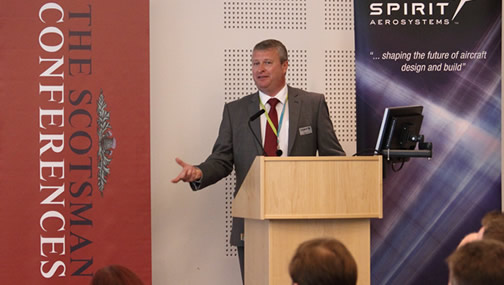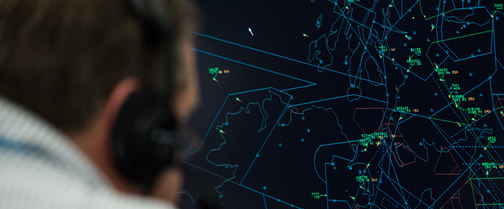Memories of 9/11
11 September 2013Two NATS air traffic controllers who were working on 11 September 2001 share their memories of that day 12 years on.
Tim Vollam, 45, Oceanic Local Area Supervisor, Prestwick Centre
I can remember that day very clearly, but it started much like any other really. I was on a day shift, starting at 10am, with plans to spend it doing some on the job training with a student controller.
It was at about 2pm that we first heard that something had happened in New York, and it became clear very quickly that this wasn’t going to be an ordinary shift. US airspace was almost immediately closed, so all the traffic that was beyond half way across the Atlantic was being diverted into Canada. However, anything nearer to Europe was going to need to turn around and come back.
You don’t use radar while working on oceanic traffic. The distances are too great for VHF comms and radar so we have to issue instructions transmitted via high frequency radio. We’re then reliant on the pilots giving us regular updates on what they want to do and their location.
The first request for a turnback came to my sector from a pilot flying from Amsterdam, but we soon started to be inundated. A turnback in itself isn’t that an unusual occurrence. People get ill on board or perhaps there is a technical problem with the aircraft and they will ask to head back to Europe. We would usually get one or maybe two a week. On that afternoon we had 85 in the space of a little over three hours.
I think that was the biggest challenge, the sheer workload, whilst knowing the enormity of what was still unfolding in the US. We were very fortunate that we had colleagues who were on their rest days volunteering to come in and help.
Looking back at it now 12 years ago I’d definitely describe it as the most challenging day of my career so far, but with the benefit of hindsight it was also the most rewarding. In circumstances like that you realise how important all the training is that we go through. It enabled us to do what needed to be done and to get all those people home safely. It is something I won’t ever forget.
Pages from the Shanwick ATC Flow logbook (click for larger):
Phil Jones, 57, Operations Supervisor, London Terminal Control
It is certainly one of those events where I think everyone can remember where they were and what they were doing. I was a north sector radar controller at the time working in the NATS London Terminal Control team.
About half an hour after I’d started my shift, people began coming back from breaks and telling the rest of us what was happening on the news. I remember very clearly how the atmosphere became quite surreal as we knew something terrible was unfolding across the Atlantic, but with planes in the air we just had to carry on working as normal.
As the enormity of what was happening became clearer, questions were being asked about how the UK should respond. The biggest fear was that there would be an attack in this country, and you could tell how nervous the pilots were. I think they just wanted to get back safely on the ground as quickly as possible.
The government was talking to NATS and the CAA about whether UK airspace should be closed as a precaution, just like the Americans had done. In the end it stayed open, but we had to change the normal procedure for aircraft on final approach into Heathrow. This meant bringing them in much tighter so that we could avoid sending them over central London, something that I don’t think we’d ever done before in a live environment.
The atmosphere remained very tense, but as the afternoon went on it actually started to become eerily quiet compared to the normal amount of aircraft we handle. In fact it was probably the quietest I’ve ever experienced alongside the first Gulf War and the Icelandic ash cloud incident.
In terms of the legacy of that day, the obvious one is security. I think anyone working in aviation will always have the events of 9/11 in the back of their minds.
Pages from the day in the London Area Control logbook (click for larger):
[Header image by Shankbone via Flickr]
Comments
Please respect our commenting policy and guidelines when posting on this website.










11.09.2013
11:48
Stuart Petts
I was the duty data systems specialist on duty at West Drayton that day. When the FAA closed the airspace we knew that things were about to get interesting.
Support staff at Scottish and London had to cancel and reenter a high number of flight plans and the various FDP systems such as NAS had to handle a lot of changes and additional information.
The operations rooms were obviously incredibly busy places but I always referred to the TC ops room looking like the stock exchange on a very bad day.
11.09.2013
12:27
David Pearson
These memories of 9/11 are fascinating social histories which coupled with the images / records of the ATC logs form historical records of the event as it unfolded from a unique perspective and that will be of interest to historians in the future. Are they being made available to any organisation on that basis?
11.09.2013
23:24
Alastair Campbell
I was working as the afternoon Watch Manager at Glasgow. My memory of that day, other than the obvious, was the Scottish Centre Supervisor’s line ringing to ask how many diversions we could take. At that point Shanwick were dealing with large numbers of aircraft turning back towards Europe following the closure of US airspace. BAA said send as many as you need. We only ended up with 6, I think, but that was a paperwork intensive day that I hope never to see again.
11.09.2019
13:42
Jeff Hills
I was at Prestwick centre on that fateful day. I clearly remember being called down to system control as it unfolded. All maintenance cancelled. Additional monitoring of essential systems from then on. All Nats staff involved did a great job on that day. Stuff that controllers weren’t trained for was dealt with.
11.09.2019
14:19
David Harriman
Heading to the US on Delta37 for a GPS conference, I just missed being on one turned back and so was on one of the many planes that landed in Gander (40 hours on plane and 3 days sleeping in a school gym floor). Due to lack of comms that we now take for granted, this meant being out of contact. I’m sure the people on those on the planes turned back are grateful on you for getting back to their families quickly: my wife was extremely worried until I managed to contact her 2 days later.
12.09.2019
20:28
Grahame White
I was ‘A’ Watch Traffic Manager in the En-Route Ops Room at West Drayton that afternoon. Around 1415 an oncoming ATSA told me that an aircraft had just flown into the World Trade Centre. I thought he meant a light aircraft that had lost control and crashed into the building but he said ‘No, an airliner’. Within a couple of minutes someone who had been watching the TV news in the ready-room confirmed that was the case and, shortly after that, a second airliner did the same.
What had started as a normal busy afternoon shift rapidly got very much busier. In addition to the routine domestic & European flights the westbound oceanic traffic had been getting airborne from UK and European airports for around 3 hours and there was still many more to get airborne.
When the signal arrived stating that US airspace was closed we had to stop all the UK oceanic departures from getting airborne, which caused a lot of problems for the major airfields, and deal with the aircraft which would be returning to the UK. I had to ask the day-shift traffic manager, doing paperwork in the downstairs office, to come to the Ops Room to help with the multitude of phone calls, trying to establish which airfields could accept diversions in, how many and up to what size. The major airports were having parking problems because stands were occupied with flights that couldn’t leave; some flights had only been airborne 20 or 30 minutes whilst some had flown nearly to mid-Atlantic and wouldn’t be back for 2 to 3 hours. I think everyone was too busy trying to maintain some sort of order, in what was an unprecedented situation, to think about the devastation and loss of life in the USA and it took many hours before the full horror of what had happened really sunk in.
I do remember that, despite a notice on the Ops Room door which said ‘No food or drink to be taken into the Operations Room’ senior management brought in trays of sandwiches and flasks of coffee at about 1900 as, apart from the legally required breaks provided for the radar controllers, very few of the other staff had been able to get a break. It was certainly an afternoon shift I will never forget.
Grahame White